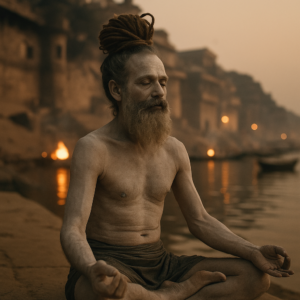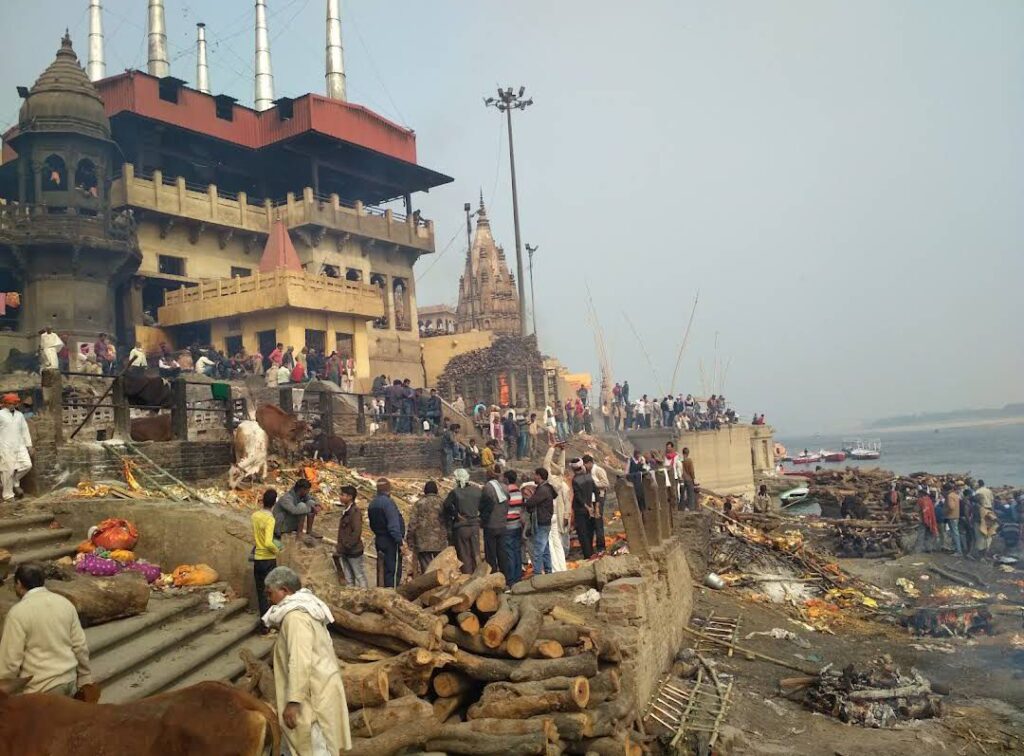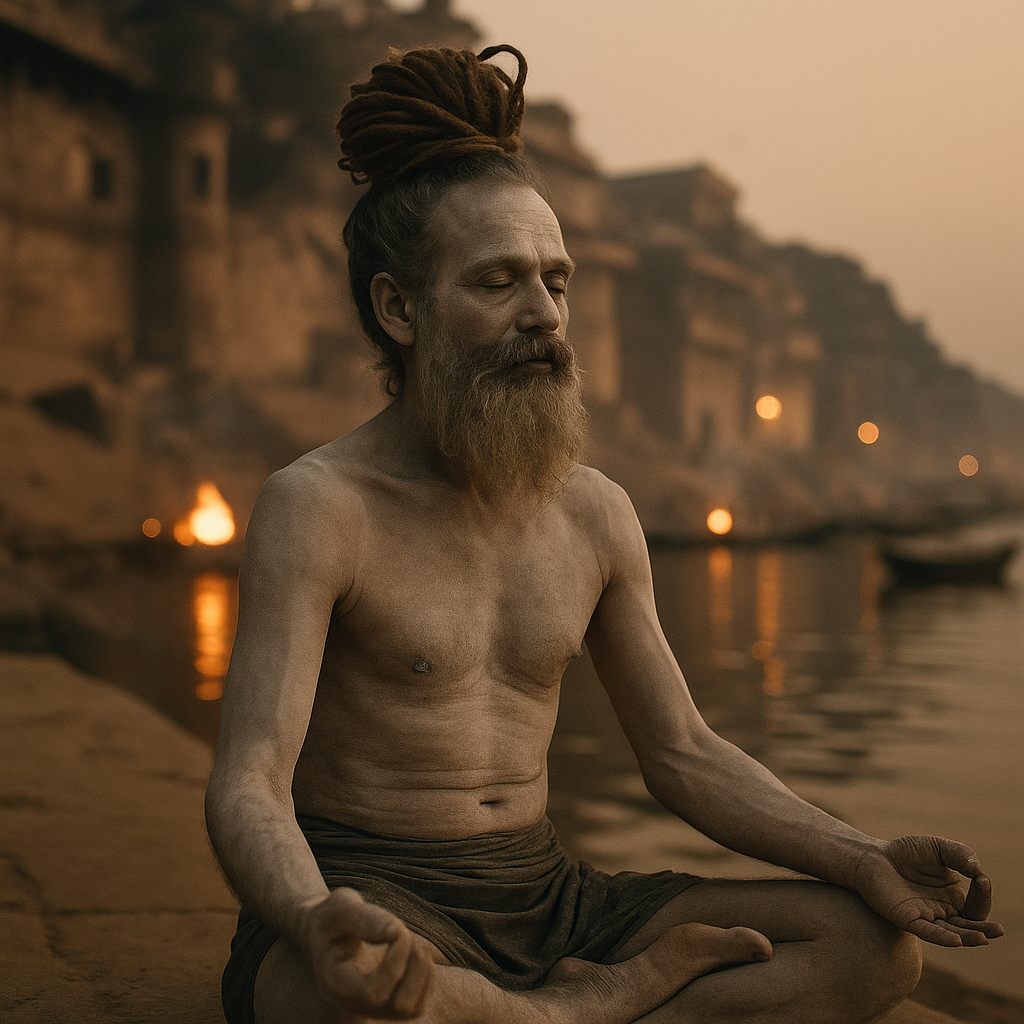Varanasi is one of the oldest cities in the world—full of life, colors, prayers, and the deep sound of temple bells. But if you stay a little longer near the ghats, especially close to the burning pyres of Manikarnika Ghat, you might come across a sight that feels straight out of a different world—men covered in ash, sitting quietly among flames and silence. These are the Aghoris.
The Aghoris are not like other saints or sadhus. They live in cremation grounds, use skulls in their rituals, and believe that nothing in this world is impure—not even death. While many people fear them or find their lifestyle strange, the Aghoris see this as the path to true freedom and spiritual power.
In this blog, we’ll explore the mysterious world of Aghori rituals in Varanasi—who they are, what they do, and why they choose to live so close to death in the city that celebrates life.
Table of Contents
Who Are the Aghoris?

The Aghoris are a small group of Hindu sadhus who follow Lord Shiva, especially in his fierce form known as Bhairava. They believe that everything in this world—good or bad, pure or impure—is a part of God. That’s why they don’t run away from things most people fear, like death, cremation grounds, or even human bones.
Unlike other sadhus who might live in peaceful forests or ashrams, Aghoris choose to stay close to burning ghats, especially in places like Manikarnika Ghat in Varanasi. To them, death is not something scary—it’s just a step toward liberation, or moksha.
They often cover their bodies in ash from cremation pyres, wear very little clothing, and live with very few belongings. You might even see them carrying a human skull (called a kapala), which they use in certain rituals. All of this may seem strange, but it’s their way of breaking the ego and showing that nothing is above or below in the eyes of the divine.
In short, the Aghoris are spiritual seekers who walk a very different path—one that most people would never dare to take.
What Do the Aghoris Believe?
The Aghoris have a very different way of thinking compared to most people. At the heart of their belief is one big idea: everything in this world is sacred. To them, there is no such thing as pure or impure—God exists in everything, even in things others avoid, like cremation grounds, dead bodies, or human bones.

They follow a path called Advaita, which means “non-duality.” This means they believe that everything—life and death, beauty and ugliness, joy and pain—is part of the same divine energy. So, nothing is dirty or wrong in their eyes. Even things that scare most people are just part of nature and should not be feared.
Aghoris also believe that by facing fear and breaking society’s rules, they can become free from worldly attachments. They aim for moksha—freedom from the cycle of life and death.
They choose to live in extreme conditions to test their minds, let go of their egos, and reach a higher level of awareness. For them, it’s not about showing off powers or looking strange—it’s about becoming one with the universe.
Common Aghori Rituals in Varanasi
Many people are curious—and sometimes even scared—about what Aghoris do in their daily lives. Their rituals are very different from what we usually see, and most of them happen near the cremation grounds of Varanasi, especially around Manikarnika Ghat.
Here are some of the most well-known Aghori rituals:
🔥 1. Living in Cremation Grounds
Aghoris spend a lot of time in places where people are cremated. For most of us, that sounds scary. But for them, it’s a powerful place to meditate. They believe being close to death reminds them that life is short—and helps them move closer to spiritual freedom.
🪔 2. Smearing Ashes on Their Bodies
Instead of wearing regular clothes, Aghoris often cover themselves in ash taken from cremation pyres. This isn’t done to shock people—it’s a symbol that the body is temporary, and one day, all of us return to ashes.
💀 3. Using Skulls in Rituals
You might see Aghoris carrying a human skull, called a kapala. They sometimes use it as a bowl or as part of their spiritual practices. For them, it’s not scary—it’s just another way to connect with the idea that life and death are part of the same journey.
🌕 4. Meditating with Corpses (Shava Sadhana)
One of the rarest and most secretive rituals is called Shava Sadhana—meditating while sitting on a dead body. This is usually done on special nights like the new moon (Amavasya). It’s believed to help the Aghori overcome fear and gain deep spiritual powers. Not all Aghoris do this, and it’s not something done openly.
🍷 5. Drinking Alcohol or Using Intoxicants
Some Aghoris drink alcohol or smoke charas (a form of cannabis) during certain rituals. These are not used for fun—they believe it helps them break mental barriers and go beyond the normal mind.
Most of these rituals might sound unusual or extreme, but they all have a deeper meaning in the Aghori path. It’s not about being wild—it’s about letting go of fear, ego, and attachments.
Why Do Aghoris Choose Varanasi?

Varanasi isn’t just any city—it’s considered one of the holiest places in India. It’s famous for its beautiful temples, the sacred River Ganga, and the belief that dying here can help the soul reach moksha (freedom from the cycle of birth and death).
For Aghoris, Varanasi is the perfect spiritual home because it’s closely connected to life, death, and rebirth. The city’s cremation ghats, especially Manikarnika Ghat, are some of the busiest places where people’s bodies are cremated every day. This constant presence of death reminds Aghoris of the true nature of life.
Also, Varanasi has a long history of tantric traditions, and the Aghoris follow some tantric practices that are linked to ancient spiritual teachings. Being in a place with such a strong spiritual energy helps them in their journey.
So, in a way, Varanasi’s mix of holiness, death, and ancient traditions makes it the ideal place for Aghoris to live and practice their rituals.
Common Misconceptions About Aghoris
Aghoris have a mysterious reputation, and because of that, many people have misunderstandings about them. Let’s clear up some common myths:
❌ They Are Evil or Dangerous
Many think Aghoris are scary or even evil because of their unusual rituals. But actually, they are spiritual seekers trying to understand life and death deeply. Their goal is to reach enlightenment, not to harm anyone.
❌ They Eat Human Flesh Regularly
Stories about Aghoris eating human flesh have made them famous in movies and books. While some extreme tales exist, most Aghoris don’t practice this. Their main focus is on meditation and spiritual growth.
❌ They Are Crazy or Insane
Some people assume that because they live differently, Aghoris are mentally unstable. But Aghoris are very focused and disciplined in their spiritual practices. Their lifestyle just looks different from normal society.
❌ They Use Their Powers to Harm Others
There’s a myth that Aghoris have supernatural powers and use them to curse or harm people. In reality, they believe in using their energy for spiritual freedom and helping others, not causing harm.
Aghoris might seem strange or even scary at first, but learning about their beliefs and rituals helps us understand that they are just people following a very unusual spiritual path.
Conclusion
The Aghoris of Varanasi live a life that most of us can’t even imagine. Surrounded by death, covered in ash, and far from worldly comforts—they walk a path that challenges every norm. But behind the shocking rituals and intense practices lies a deep search for truth, freedom, and connection with the divine.
They remind us that spirituality isn’t always about temples, prayers, or peaceful chants. Sometimes, it’s about facing our deepest fears and finding light in the darkest places.
Whether we agree with their ways or not, the Aghoris teach us one important lesson—everything in this world is part of the same creation, and nothing should be feared or rejected without understanding.
So the next time you visit Varanasi and spot a figure sitting quietly by the burning ghats, don’t be quick to judge. You might just be looking at someone walking one of the most fearless spiritual paths known to humankind.
Frequently Asked Questions (FAQ)
1. Who are the Aghoris?
Aghoris are a group of Hindu sadhus (holy men) who follow a unique spiritual path. They believe that everything in the world—good or bad, pure or impure—is sacred and part of the divine.
2. Why do Aghoris live near cremation grounds?
They believe that facing death directly helps them overcome fear and attachments. Cremation grounds are seen as powerful places for meditation and spiritual growth.
3. Do Aghoris really eat human flesh?
This is one of the most talked-about topics. While some rare rituals involve this, it’s extremely uncommon and symbolic, not a regular practice. Most Aghoris focus on meditation and spiritual discipline.
4. Are Aghoris dangerous?
No, Aghoris are not dangerous. Their appearance and practices may seem intense, but their aim is spiritual freedom, not to harm anyone.
5. Why do Aghoris use human skulls?
They use skulls, called kapalas, in rituals as a reminder that life is temporary. It’s a symbol to let go of ego and worldly desires.
6. Can you meet an Aghori in Varanasi?
Yes, especially near Manikarnika Ghat, you might see Aghoris. However, they usually prefer to be left alone. If you do approach one, always be respectful.
If you’ve enjoyed reading this article, you might like:

